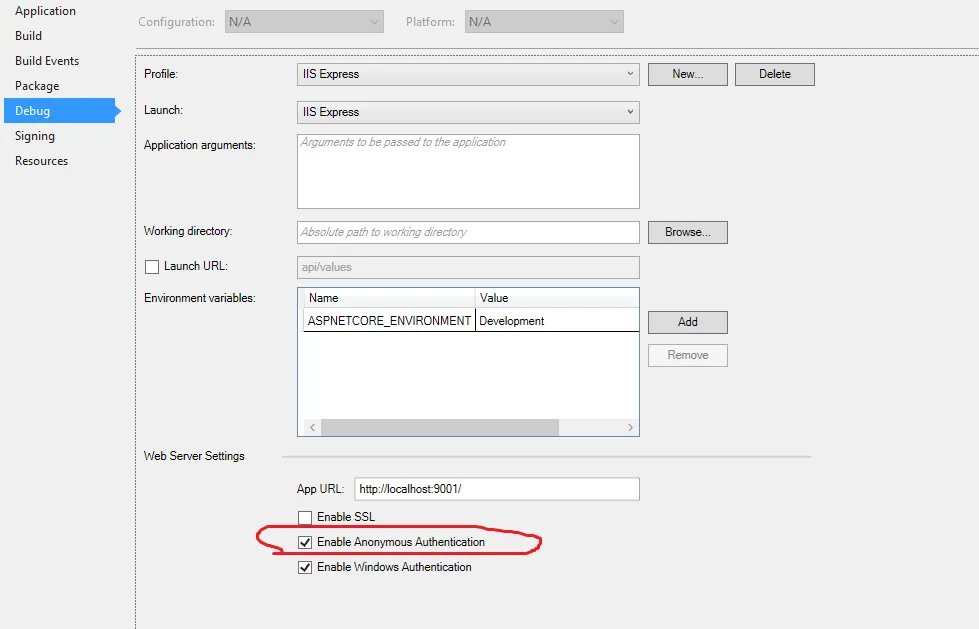我完全陷入了实现 .NET Core 应用程序的 Windows 身份验证中,该应用程序使用 Aurelia 作为客户端。Aurelia 应用程序托管在端口:9000 上,而 .NET WebAPI 托管在端口:9001 上。想法是发布应用程序后从我的 .NET 应用程序提供静态页面,但现在在开发中,由于 Aurelia 提供的 BrowserSync,我使用端口:9000。当我使用端口:9000 时,一切都很好,我没有任何问题进行发布或获取。如果我切换到端口:9001,则仍然可以获取但无法发布,发布会导致“401 未经授权”的错误。如果我们查看请求端口:9000 的标头... 可以看到,在某些情况下,发布中缺少多个标头,最重要的是身份验证 cookie。Base-Repo.js
当使用BrowserSync端口时,为什么GET有效而POST无效?
编辑1
端口9001的Post(成功):
编辑2 控制台消息post错误:
OPTIONS http://localhost:9001/api/MYURLS 401 (未经授权) Fetch API无法加载http://localhost:9001/api/MYURLS。预检请求的响应未通过访问控制检查:所请求的资源上没有“Access-Control-Allow-Origin”标头。因此,不允许从源http://localhost:9000访问。响应的HTTP状态代码为401。如果不透明的响应符合您的需求,请将请求的模式设置为“no-cors”,以禁用CORS获取资源。
编辑3
Startup.cs
import {inject} from 'aurelia-framework';
import {HttpClient, json} from 'aurelia-fetch-client';
import {AppSettings} from '../infrastructure/app-settings';
@inject(HttpClient, AppSettings)
export class BaseRepo {
constructor(http, appSettings) {
http.configure(config => {
config
.withDefaults({
credentials: 'include',
headers: {
'Accept': 'application/json'
}
})
.withInterceptor({
request(request) {
console.log(`Requesting ${request.method} ${request.url}`);
return request;
},
response(response) {
console.log(`Received ${response.status} ${response.url}`);
return response;
}
})
});
this.http = http;
this.baseUrl = appSettings.api;
}
get(url) {
console.log('BaseRepo(get): ' + url);
return this.http.fetch(this.baseUrl + url)
.then(response => { return response.json(); })
.then(data => { return data; });
}
post(url, data) {
console.log('BaseRepo(post): ' + url, data);
return this.http.fetch(this.baseUrl + url, {
method: 'post',
body: json(data)
})
.then(response => response.json())
.then(data => { return data; });
}
}
当使用BrowserSync端口时,为什么GET有效而POST无效?
编辑1
端口9001的Post(成功):
编辑2 控制台消息post错误:
OPTIONS http://localhost:9001/api/MYURLS 401 (未经授权) Fetch API无法加载http://localhost:9001/api/MYURLS。预检请求的响应未通过访问控制检查:所请求的资源上没有“Access-Control-Allow-Origin”标头。因此,不允许从源http://localhost:9000访问。响应的HTTP状态代码为401。如果不透明的响应符合您的需求,请将请求的模式设置为“no-cors”,以禁用CORS获取资源。
编辑3
Startup.cs
public class Startup
{
public Startup(IHostingEnvironment env)
{
var builder = new ConfigurationBuilder()
.SetBasePath(env.ContentRootPath)
.AddJsonFile("appsettings.json", optional: false, reloadOnChange: true)
.AddJsonFile($"appsettings.{env.EnvironmentName}.json", optional: true)
.AddEnvironmentVariables();
Configuration = builder.Build();
env.ConfigureNLog("nlog.config");
}
public IConfigurationRoot Configuration { get; }
public void ConfigureServices(IServiceCollection services)
{
services.AddCors(options =>
{
options.AddPolicy("CorsPolicy",
builder => builder.AllowAnyOrigin()
.AllowAnyMethod()
.AllowAnyHeader()
.AllowCredentials());
});
services.AddMemoryCache();
services.AddMvc();
services.InjectWebServices();
services.AddOptions();
//call this in case you need aspnet-user-authtype/aspnet-user-identity
services.AddSingleton<IHttpContextAccessor, HttpContextAccessor>();
services.AddSingleton<IConfiguration>(Configuration);
}
public void Configure(IApplicationBuilder app, IHostingEnvironment env, ILoggerFactory loggerFactory)
{
app.UseCors("CorsPolicy");
loggerFactory.AddConsole(Configuration.GetSection("Logging"));
loggerFactory.AddDebug();
app.UseMvc();
app.UseDefaultFiles();
app.UseStaticFiles();
//add NLog to ASP.NET Core
loggerFactory.AddNLog();
//add NLog.Web
app.AddNLogWeb();
}
}

IServiceCollection上调用了AddCors并确保UseCors在UseMvc之前? - Kirk Larkin